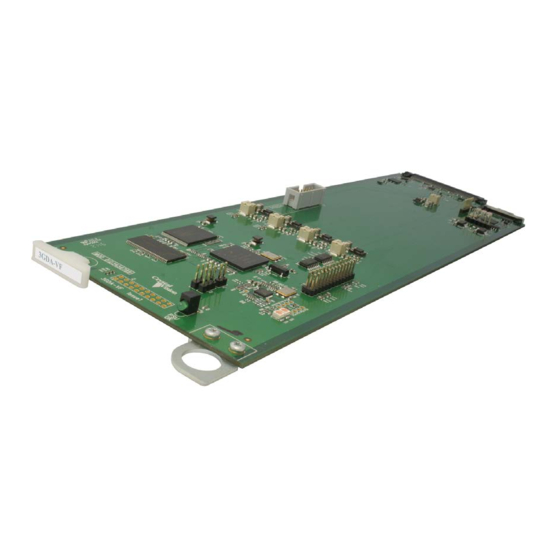Table of Contents
Advertisement
Quick Links
Advertisement
Table of Contents

Summary of Contents for Crystal Vision 3GDA-VF
- Page 1 3GDA-VF 3G/HD/SD Video or MADI (AES10) Distribution Amplifier Crystal Vision Ltd., Lion Technology Park, Station Road East, Whittlesford, Cambridge, CB22 4WL, England. Tel: +44(0) 1223 497049 Fax: +44(0) 1223 497059 sales@crystalvision.tv www.crystalvision.tv...
-
Page 2: Table Of Contents
Rear module connections with VR20 Rear module connections with VR16 Rear module connections with VR15 Status monitoring Controlling cards via VisionWeb Menu Structure Control Descriptions Status Control Troubleshooting Card edge monitoring Basic fault finding guide Specification 3GDA-VF User Manual R1.0 19 June 2017... -
Page 3: Introduction
‘VisionPanel’ control panel, SNMP or ‘VisionWeb’ PC software. 3GDA-VF block diagram The 3GDA-VF can use either the VR20 or VR16 single-slot rear modules or the VR15 double- slot rear module. The VR20 has seven BNC connectors with one input and six outputs; the VR16 has ten Micro BNC connectors with one input and nine outputs;... - Page 4 Auto cable equalisation appropriate to the input signal type. Auto output slew rate control for SD and HD/3G signals. Up to 20 3GDA-VF in a ‘Vision 3’ 3U frame depending on rear module. Less than 50ns delay. Ancillary data passed from input to all outputs.
-
Page 5: Hardware Installation
Crystal Vision Hardware installation 2 Hardware installation 2.1 Board Configuration 3GDA-VF main board Link Configuration The 3GDA-VF has no user-selectable links. Any links or controls should remain in their factory set positions. 3GDA-VF User Manual R1.0 19 June 2017... -
Page 6: Rear Modules And Signal I/O
Rear Modules and Signal I/O 3 Rear Modules and Signal I/O The 3GDA-VF distribution amplifier fits into all ‘Vision’ rack frames from Crystal Vision and can be plugged in and removed while the frame is powered without damage. ‘Vision’ frames all have a hinged front panel that gives access to the PSUs and all cards. The universal frame wiring system allows any of the interface range of cards to be fitted in any position with the use of removable rear modules. -
Page 7: Rear Module Connections With Vr16
Micro BNC connectors to provide one 3G/HD/SDI/ASI or MADI input and nine 3G/HD/SD/ASI or outputs. MADI serial digital input Up to 20 VR16 rear modules can fit into a Vision 3 frame. 3G/HD/SD/ASI or MADI serial digital outputs 3GDA-VF User Manual R1.0 19 June 2017... -
Page 8: Rear Module Connections With Vr15
The VR15 double-slot rear module uses BNC connectors to provide one 3G/HD/SDI/ASI or MADI input and 12 outputs. Up to ten VR15 rear modules can fit into a Vision 3 frame. 3GDA-VF User Manual R1.0 19 June 2017... -
Page 9: Status Monitoring
Typical ‘Vision 3’ frame homepage The example above shows a 3GDA-VF card fitted in slot 1 and other Vision cards in slots 2, 3, 5 and 7. Clicking on the 3GDA-VF card will bring up the card’s home page, for example: 3GDA-VF Status Page 3GDA-VF User Manual R1.0... -
Page 10: Menu Structure
Crystal Vision Status monitoring 4.2 Menu Structure Operators of a ‘Vision’ frame active front panel or VisionPanel should use the following tree to access the 3GDA-VF controls: Status Input Present Control Format Reclocker Mode Auto Bypass MADI Unlocked DVB/ASI Slew Rate... -
Page 11: Control
Mode control is set to ‘Bypass’ or if the input is unlocked. Click on this button to return the card to its default values: Card default reclocker ‘Mode’ control set to ‘Auto’ and ‘Slew Rate’ control set to ‘SD’. 3GDA-VF User Manual R1.0 19 June 2017... -
Page 12: Troubleshooting
If required, the card may be reset by removing the card from the rack and then re-inserting it. It is safe to re-insert the card whilst the rack is powered. Any previous configuration will be retained. 3GDA-VF User Manual R1.0 19 June 2017... -
Page 13: Specification
VisionWeb Control which is available via the web server on the frame and allows operation using a standard web browser on a PC or tablet. Complimentary SNMP control and monitoring via frame CPU and Ethernet connection. 3GDA-VF User Manual R1.0 19 June 2017...










Need help?
Do you have a question about the 3GDA-VF and is the answer not in the manual?
Questions and answers